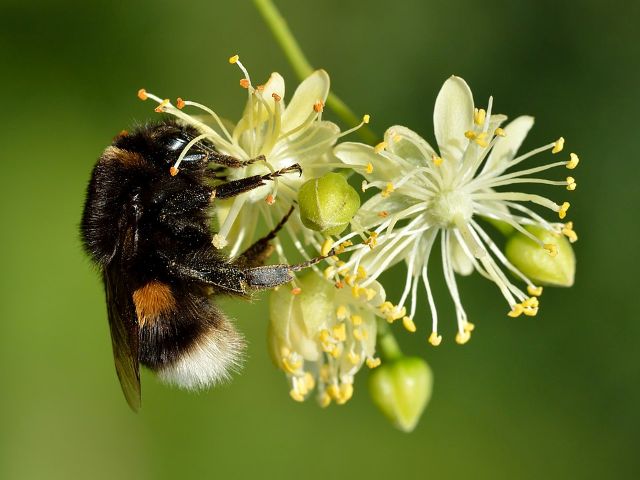Assassin bug Pahabengkakia piliceps hunts bees with their own weapon
The assassin bug Pahabengkakia piliceps specializes in capturing stingless bees. To do so, it uses the resin with which the bees defend their nest, Zhaoyang Chen and colleagues show.
To protect their nest against small predators such as ants, beetles and spiders, workers of the stingless bee Trigona collina apply drops of plant resin around the nest entrance and guard bees keep an eye on the entrance. The defence is adequate: unwanted visitors are trapped in the resin and can be eliminated. But one predator is unaffected and even sabotages the system: the assassin bug Pahabengkakia piliceps. It uses the resin to catch the bees themselves, Zhaoyang Chen and colleagues write.
The stingless bee Trigona collina lives in Thailand and China. It establishes colonies in cavities in termite nests, soil, trees or, sometimes, walls of buildings. A nest is surrounded by a wall and accessible through a thin tube of wax and resin.
Sticky
The assassin bug Pahabengkakia piliceps goes to this entrance tube and smears its front and middle legs with resin that the bees have deposited there for defence. Remarkably, the bees do not interfere. With the sticky legs raised, the bug then can grasp bees that approach it – and that are faster than it – immobilize them, take them to its hiding place and pierce them with its stylet (rostrum) to suck their haemolymph (insect blood).
But it is not the stickiness of the resin alone that helps him capture bees, Chen discovered. When, in an experiment, he smeared resin on the hind legs and abdomen of an assassin bug instead of the front and middle legs, the bug was less successful in capturing bees. But the guard bees approached it just as fanatic. Why?
Aromatic
The researchers show that resin on an assassin bug emits more volatile substances, and is therefore more aromatic, than resin droplets at the nest entrance. This is because resin that is evenly spread on a moving animal dries out less quickly.
And the strong resin smell works as a lure. It is also released when an animal ends up in a resin droplet and struggles to get loose, a signal to the guards to go for it. The smeared predatory bug imitates that struggle and in doing so, it attracts bees that it can then easily catch with its sticky front and middle legs. It uses the bees’ resin as a tool for its own purpose: to obtain food.
He uses the bees’ defence weapon against them.
Specialist
There are other assassin bugs that catch their prey with sticky legs, but they are not as specialized as Pahabengkakia piliceps, which only has a few species of stingless bees on its menu. Not only does it catch bees with their own weapon, but sometimes it also lays eggs in the bee nest. The young bugs (nymphs) that emerge from these are not recognized as foreign by the hosts because their body shape resembles that of bees. They feed on the brood of the bees and on adult workers in the nest.
Defence mechanisms of Trigona collina can’t get a grip on the specialized predator Pahabengkakia piliceps.
Willy van Strien
Photo: assassin bug Pahabengkakia piliceps at the entrance of a bee nest. © Zhaoyang Chen
Hunting Pahabengkakia piliceps on YouTube
See also: a generalist sticky assassin bug
Sources:
Chen, Z., L. Tian, J. Ge, S. Wang, T. Chen, Y. Duan, F. Song, W. Cai, Z. Wang & H. Li, 2025. Tool use aids prey-fishing in a specialist predator of stingless bees. PNAS 122: e2422597122. Doi: 10.1073/pnas.2422597122
Jongjitvimol, T. & W. Wattanachaiyingcharoen, 2007. Distribution, nesting sites and nest structures of the stingless bee species, Trigona collina Smith, 1857 (Apidae, Meliponinae) in Thailand. The Natural History Journal of Chulalongkorn University 7: 25-34. Doi: 10.58837/tnh.7.1.102916
Wattanachaiyingcharoen, W. & T. Jongjitvimol, 2007. First record of the predator, Pahabengkakia piliceps Miller, 1941 (Reduviidae, Harpactorinae) in the stingless bee, Trigona collina Smith, 1857 (Apidae, Meliponinae) in Thailand. The Natural History Journal of Chulalongkorn University 7: 71-74. Doi: 10.58837/tnh.7.1.102921












